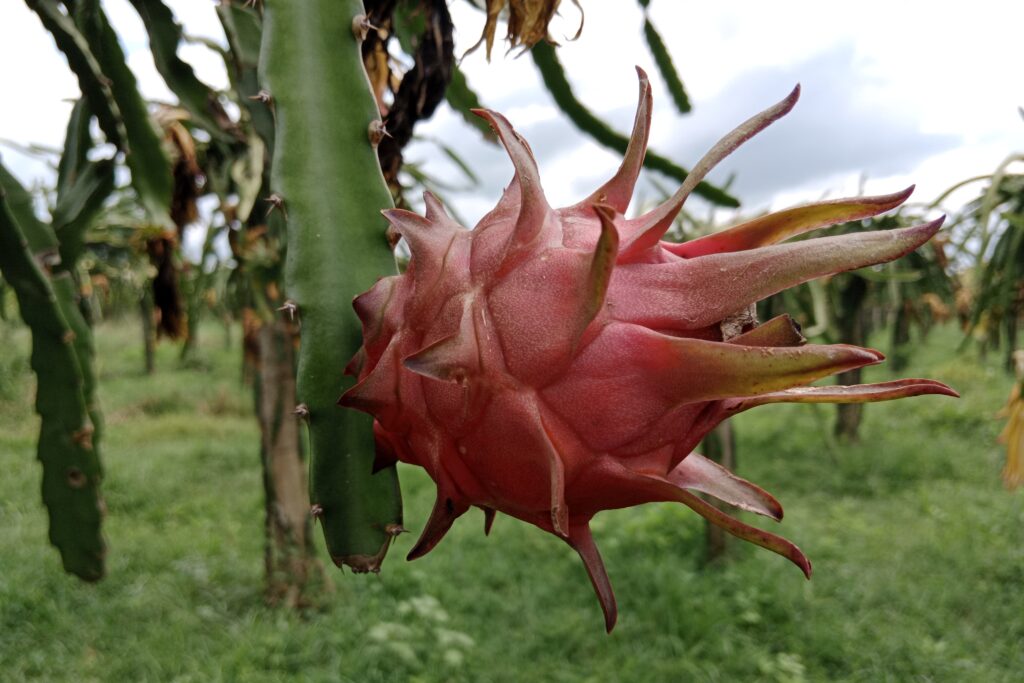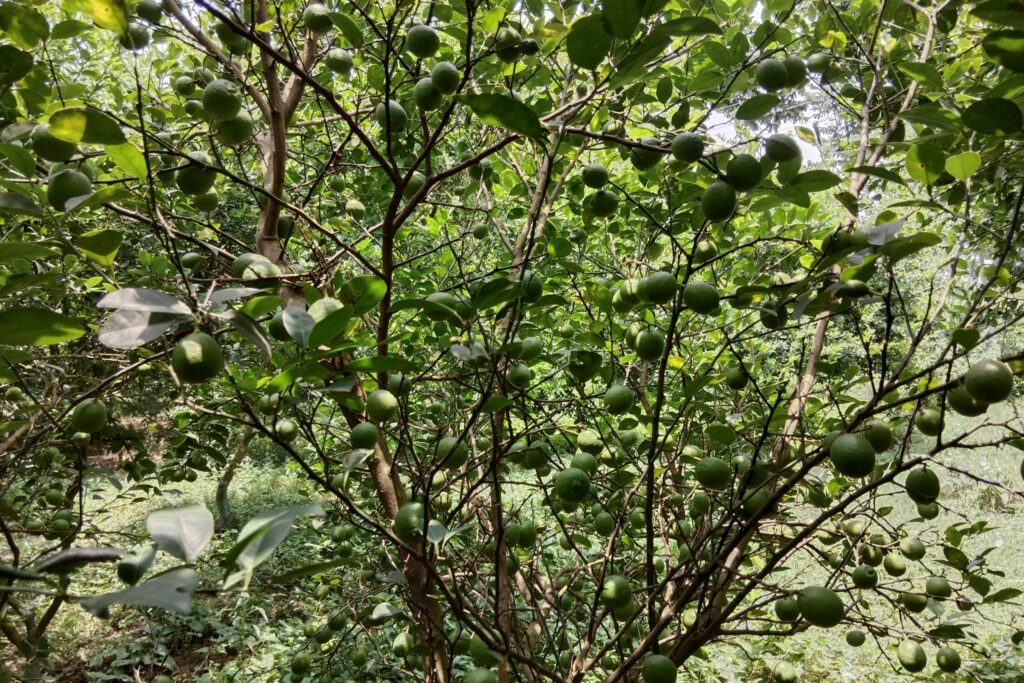Cotton Farming
A detailed examination of cotton farming profit per acre reveals a substantial net gain for cultivators. The total investment required per acre stands at NRs. 90,000, covering essential inputs from land preparation to post-harvest processing. Against this expenditure, the revenue generated from selling an estimated yield of 1,100 kg of cotton at NRs. 200 per kg results in a significant total income of NRs. 220,000 per acre.
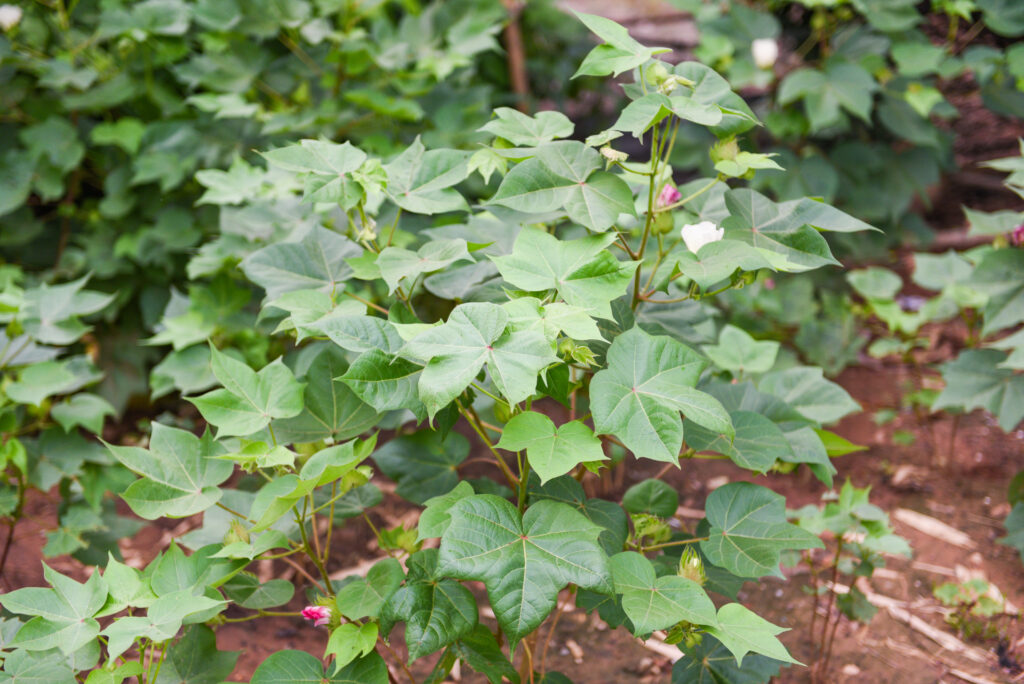
This translates to a robust net profit of NRs. 130,000 per acre, achieved after deducting all production costs. Calculating the cotton farming profit per acre further demonstrates exceptional efficiency, yielding a remarkable profit margin of approximately 144.4%. This compelling figure for cotton farming profit per acre highlights the strong economic potential of this agricultural enterprise under the given cost and market conditions.
Land Preparation
The process of land preparation involves several crucial steps to ensure optimal seedbed conditions. Initial deep plowing (8–12 inches) with a moldboard plow after the previous crop, ideally during summer, exposes the soil to sunlight, aiding in pest and disease control while promoting organic matter decomposition.
Following rains, repeated harrowing with disc harrows breaks clods and levels the field. Pre-sowing irrigation (roling) is applied 10–15 days before sowing to maintain adequate soil moisture for germination. After irrigation, final tillage involves 2–3 light harrowings or cultivator passes to create a fine tilth, followed by smoothing and compacting with a plank or leveler. This comprehensive preparation ensures good seed-soil contact, uniform germination, effective weed control, and easy root penetration, fostering better crop establishment.
Soil Type
Cotton thrives best in deep, well-drained, and fertile loamy soils such as sandy loam, clay loam, and silt loam, offering good water-holding capacity and aeration. While it can tolerate sandy soils (requiring more frequent irrigation and fertilization) and well-drained clay soils (to avoid waterlogging), it is critical to maintain good internal drainage to prevent root rot. Cotton prefers a slightly acidic to alkaline pH range of 5.8–8.0, with an optimal range of 6.0–7.0, and should be cultivated in non-saline, non-sodic soils for optimal growth.
Climatic Requirements
| Climatic Requirement | Details |
| Temperature | Germination: Minimum 15–16°C, Optimum 30–32°C |
| Growth: Warm days (27–32°C) and cool nights (18–21°C) are ideal | |
| Flowering & Boll Development: Requires warm temperatures (21–27°C); frost is detrimental | |
| Sunshine | Requires abundant sunshine (at least 180–200 frost-free days) during flowering and boll opening |
| Rainfall | Moderate: 500–650 mm, well-distributed throughout the growing season |
| Critical Periods: Moisture is essential during germination, flowering, and boll formation; dry weather is crucial during boll opening and harvest | |
| Drought Tolerance: Moderately drought-tolerant once established, but severe stress reduces yields | |
| Humidity | Low to moderate humidity during boll opening and harvest reduces fungal diseases and fiber staining |
Major Cultivars
Cotton cultivars are classified into the following categories based on fiber length:
| Category | Variety/Hybrid | Key Features |
| Long Staple/fiber length | Moti | Fusarium wilt tolerant, 165 days maturity, yield 8.45 qtl/acre, ginning outturn 38.6%. |
| LD 327 | Tolerant to Fusarium wilt, 175 days maturity, yield 11.5 qtl/acre, ginning outturn 41.9%. | |
| PAU Bt 1 | Moderately resistant to cotton curl disease, yield 11.2 qtl/acre, ginning outturn 41.4%. | |
| Medium Staple/fiber length | RCH 134 BT | Resistant to bollworm and American bollworm, 160-165 days maturity, yield 11.5 qtl/acre, ginning outturn 34.4%. |
| RCH 317 BT | Resistant to spotted and American bollworm, 160-165 days maturity, yield 10.5 qtl/acre, ginning outturn 33.9%. | |
| MRC 6301 BT | Resistant to spotted and American bollworm, 160-165 days maturity, yield 10 qtl/acre, ginning outturn 34.7%. | |
| MRC 6304 BT | Resistant to spotted and American bollworm, 160-165 days maturity, yield 10.1 qtl/acre, ginning outturn 35.2%. | |
| Ankur 651 | Jassid tolerant, 170 days maturity, yield 7 qtl/acre, ginning outturn 32.5%. | |
| Whitegold | Leaf curl virus tolerant, 180 days maturity, yield 6.5 qtl/acre, ginning outturn 30%. | |
| LHH 144 | Leaf curl resistant, 180 days maturity, yield 7.6 qtl/acre, ginning outturn 33%. | |
| BCHH 6488 BG II | Susceptible to cotton leaf curl, 165-170 days maturity, fibre length 27 mm, ginning outturn 34.5%. | |
| MRC 7017 BG II | Resistant to multiple bollworms and leaf curl virus, 29.7 mm fibre length, ginning outturn 33.6%, yield 10.4 qtl/acre. | |
| Short Staple/fiber length | FMDH 9 | Jassid and whitefly resistant, 160 days maturity, fibre length 23.4 mm, ginning outturn 37.3%, yield 10 qtl/acre. |
| FDK 124 | Whitefly and jassid resistant, 160 days maturity, fibre length 21 mm, ginning outturn 36.4%, yield 9.3 qtl/acre. | |
| LD 1019 | Resistant to shattering, 2-3 pickings required, fibre length 22.6 mm, ginning outturn 35.77%, yield 8.6 qtl/acre. |
Seed rate
Seed rates vary significantly based on the planting system and variety type: normal varieties typically require 2–3 kg per acre for conventional spacing, while High-Density Planting (HDP) systems demand 4–5 kg per acre to support closer plant spacing and higher populations; in contrast, hybrid varieties need only 1–1.5 kg per acre due to their wider spacing requirements and vigorous growth.
Planting
a). Planting Season
Cotton planting is typically conducted from April to June.
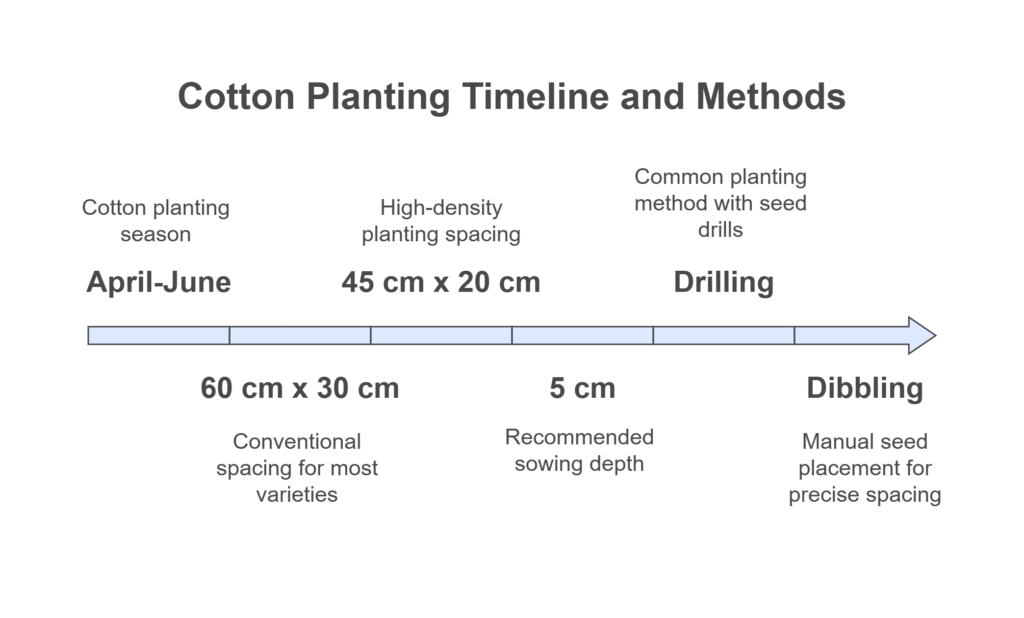
b) Spacing
The spacing for cotton planting varies based on the variety. Most varieties are planted at a spacing of 60 cm x 30 cm, while high-density planting (HDP) requires a spacing of 45 cm x 20 cm. The recommended sowing depth is 5 cm.
c) Planting Method
The planting method for cotton includes several techniques. Drilling is the most common, where seeds are placed 2.5–5 cm deep using manual, mechanical, or tractor-drawn seed drills in furrows along rows. Broadcasting is less efficient, as it results in uneven depth and spacing, requires a higher seed rate, and is typically followed by light planking. Dibbling involves manually placing seeds in holes made with a dibbler, ensuring precise spacing similar to drilling.
d) Number of Plants per Acre
Conventional Spacing: 22483 plants/acre (60cm x 30cm).
High Density Planting (HDP): 44967 plants/ acre (45cm x 20cm).
Irrigation
Cotton requires 4–6 irrigations depending on rainfall intensity. The first irrigation should be given 4–6 weeks after sowing, with subsequent irrigations at intervals of 2–3 weeks. Critical stages for irrigation include branching and square formation (45–50 days after sowing), flowering and fruiting (75–85 days after sowing), boll formation (95–105 days after sowing), and boll development and opening (115–125 days after sowing).
Ensure no waterlogging occurs, especially in young plants, and avoid water stress during flowering and fruiting to prevent flower and boll shedding. The final irrigation should be applied when 33% of the bolls have opened, after which further irrigation is unnecessary. When using saline water, testing by an authorized laboratory is recommended, and amendments like gypsum or pyrite may be added as advised. In drought conditions, alternate furrow irrigation and micro-irrigation systems (where feasible) can significantly conserve water.
Fertilizer and Manure
For Bt varieties, apply basal fertilizers at 65 kg Urea + 27 kg DAP (or 75 kg SSP) per acre, supplying 30 kg N and 12 kg P. Non-Bt varieties require 130 kg Urea + 27 kg DAP (or 75 kg SSP), providing 60 kg N and 12 kg P; potassium doses depend on soil conditions. Enhance yield with 2–3 foliar sprays of Potassium (10 g/L) and DAP (20 g/L) at 15-day intervals from first bloom.
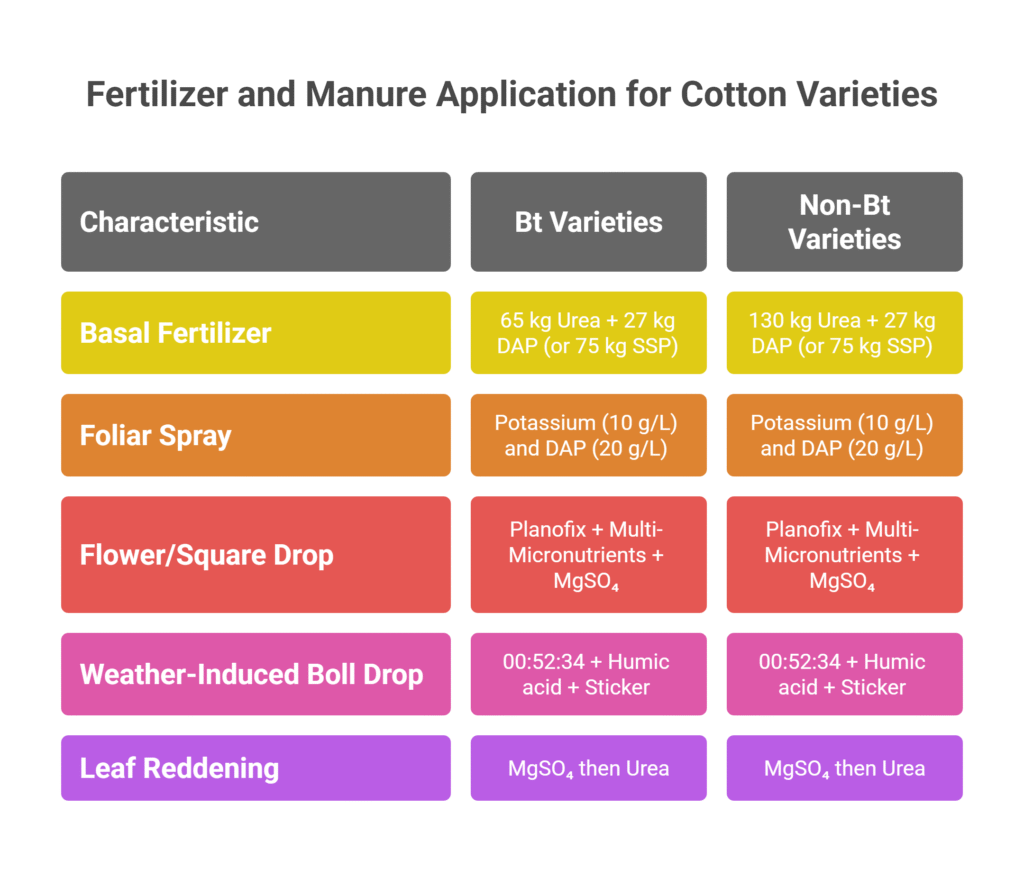
Combat flower/square drop with Planofix (NAA @4 ml) + Multi-Micronutrients (120 g) + MgSO₄ (150 g) in 15L water. For weather-induced boll drop, spray 00:52:34 (100 g) + Humic acid (>12% @30 ml) + Sticker (6 ml) in 15L water thrice at 10-day intervals. Correct leaf reddening (nutrient deficiency) using sequential sprays: MgSO₄ (1 kg) then Urea (2 kg) in 100L water.
Weed Control
The critical weed management period for cotton is the first 50–70 days until canopy closure, as weeds compete intensely for light, water, and nutrients.
Effective methods include cultural practices like timely sowing, optimum plant population, intercropping, and clean cultivation; mechanical methods such as pre-sowing tillage and 2–4 early-season hoeings/weeding; and chemical control with pre-plant herbicides like Glyphosate for perennial weeds, pre-emergence herbicides like Pendimethalin, and post-emergence herbicides like Quizalofop-ethyl (grasses) or Pyrithiobac-sodium (broadleaves). An integrated approach, combining methods such as pre-emergence herbicide use with timely hoeings, ensures effective and sustainable weed control.
Pest and Disease Management
Common Pests
a). American Bollworm
American Bollworm eggs are laid singly on leaves, with larvae initially yellowish white (brown-black head) turning darker brown; infestation causes circular holes in bolls and granular fecal pellets, with one larva damaging 30-40 bolls. Management: Monitor using light/pheromone traps; avoid cotton monocropping/continuous cropping—instead, intercrop with less preferred crops (e.g., pulses, sorghum, castor) or use border crops.
Remove previous crop residues pre-sowing, optimize irrigation, limit nitrogen, and plant resistant varieties. Avoid synthetic pyrethroids; for severe outbreaks, spray Cypermethrin, Deltamethrin, Fenvalerate, or Lambda-cyhalothrin (1ml/L water), rotating chemical groups to prevent resistance.
b). Thrips
Thrips damage cotton by having both nymphs and adults feed on leaf undersides through lacerating sap, turning the upper surface brown and lower surface silvery-white; to manage, treat seeds with imidacloprid 70 WS (7 ml/kg) for protection against thrips, aphids, and leafhoppers for up to 8 weeks, and if infestations persist, spray any one of Methyl demeton 25 EC (160 ml/acre), Buprofezin 25% SC (350 ml/acre), Fipronil 5% SC (200–300 ml/acre), Imidacloprid 70% WG (10–30 ml/acre), or Thiamethoxam 25% WG (30 gm/acre) in 200 liters of water per acre as needed.
c) Spotted bollworm
Noticed Larvae of boltworms have rows of black spots on their bodies and are dull green with black bristles. During the pre-flowering stage, infestation results in terminal shoots drooping and drying out, as well as boll holes that induce boll rot. Apply 500 ml of Profenophos 50 EC per 200 liters of water per acre to control infestation.
d) Tobacco Caterpillar
The pest attacks crops in groups, scraping the leaf epidermis and leaving only the vein skeleton, sometimes leaving just stems and side shoots standing. Tobacco caterpillar eggs are golden brown and clustered, while larvae are greenish and found in clusters. Use light traps to monitor pest intensity and set sex pheromone traps at five per acre. Manually inspect and destroy larvae early, including mature caterpillars. For heavy infestations, spray insecticides like Chlorantraniliprole 18.5% SC (50 ml/acre), or Diflubenzuron 25% WP (100–150 g/acre), applying sprays early morning or evening for best results.
e). Jassids
Jassids damage cotton through sap-sucking by nymphs and adults on leaf undersides, causing upward curling followed by red-to-brown discoloration, drying, and premature shedding; for control, apply Carbofuran 3G (14 kg/acre) or Phorate 10G (5 kg/acre) to moist soil near the root zone, and if >50% of plants show yellowing/curling in the upper canopy, spray Imidacloprid 17.8 SL (40–50 ml), Thiamethoxam (40 gm), or Acetamiprid (75 gm) per 200L water/acre.
f) Pink Bollworm
Pink Bollworm larvae progress from white in early stages to variable late-instar colors (black, brown, green, pale, or pink). Monitor adult moths with pheromone traps; apply Carbaryl 5% dust (10 kg/acre) upon initial infestation detection. For severe outbreaks, spray Triazophos 40 EC (300 ml/acre).
Common Diseases
a). Alternaria Leaf Spot
Characterized by small, pale-to-brown circular or irregular spots with broad margins on leaves, this disease causes affected foliage to dry and shed; it may also form stem cankers and spread to bolls, leading to rotting and premature dropping. Plants under drought stress, nutrient deficiency, or pest damage are highly vulnerable.
For control, preventive sprays of Tebuconazole (1 ml/L) or Trifloxystrobin + Tebuconazole (0.6 g/L) are recommended at 60, 90, and 120 days after sowing. If disease symptoms appear, apply Curative sprays of Copper Oxychloride/Captan (500 g/200L water/acre) or Carbendazim 12% + Mancozeb 63% WP (25 g/10L water).
b). Fusarium Wilt
Fusarium wilt affects cotton at all growth stages, causing stunted growth, yellowing that starts at leaf edges, defoliation, earlier fruiting, smaller bolls, and black discoloration beneath the bark. To manage the disease, use resistant varieties, practice proper crop rotation, avoid continuous cotton planting, and ensure good drainage. Treat seeds with Trichoderma viride formulation at 4 g/kg of seed. For control, apply a solution of Thiophanate Methyl (10 g) and Urea (50 g) in 10 liters of water near the plant base.
c). Cercospora Leaf Spot
Circular red lesions on leaves enlarge and develop white or grey centers with concentric rings and red margins, often turning dark grey due to spore masses in the center. To manage the disease, spray Copper Oxychloride at 3 g/L or Mancozeb at 2.5 g/L, applying 3–4 sprays at 15-day intervals.
d). Anthracnose
Anthracnose causes small reddish or light-colored spots on leaves, stem wounds that weaken the plant, and attacks bolls at any stage, spreading infection to lint and seed. Affected bolls show small, water-soaked, circular, slightly depressed reddish-brown spots. To manage the disease, treat seeds before sowing with Captan or Carbendazim at 3–4 g/kg, avoid waterlogging, remove and destroy infected plants, and spray Carbendazim at 1 g per liter of water if infection occurs.
e). Root rot
Root rot causes sudden, complete wilting and yellowing of leaves, with affected plants easily pulled out due to decayed roots, while only a few secondary roots remain fresh to hold the plant. To reduce incidence, apply neem cake at 60 kg/acre to the soil before sowing and treat seeds with Trichoderma viride at 4 g/kg. If an infection occurs, perform spot drenching with Carbendazim at 1 g per liter at the base of affected and nearby healthy plants.
Harvesting
Harvesting cotton occurs 150–210 days after sowing, depending on the cultivar and climate, when bolls are fully mature, dry, and burst open, exposing clean, fluffy lint, typically requiring 2–3 pickings at 10–15 day intervals. Signs of maturity include dry brown bolls, hard dark seeds, and naturally or chemically defoliated plants.
Common methods include manual selective picking, which is labor-intensive but yields the highest quality fiber by harvesting only fully opened bolls through multiple passes; stripping, either manual or mechanical, which removes both open and unopened bolls faster but lowers fiber quality due to trash and immature fiber; and mechanical harvesting with spindle pickers, which mimic hand picking for better quality and multiple pickings, or stripper harvesters that rapidly remove all bolls in one pass after chemical defoliation but produce more trash.
Pre-Harvest Practices
a). Defoliation
Defoliation involves applying chemicals like Thidiazuron or Ethephon to remove cotton leaves before harvest, enabling efficient mechanical picking while minimizing trash and fiber staining, with precise timing being critical for effectiveness.
b). Desiccation
Desiccation involves applying fast-acting chemicals like Paraquat (restricted/banned in many regions due to toxicity concerns) to rapidly dry cotton plants pre-harvest, enabling efficient mechanical stripper harvesting.
Post-Harvest
Post-harvest handling of cotton is critical to maintaining fiber quality and preventing deterioration. Immediate ginning, which separates the lint from the seeds, is essential to avoid damage caused by prolonged storage of seed cotton (kapas). If ginning cannot be done immediately, it is important to store the seed cotton in dry, well-ventilated conditions to minimize moisture buildup and reduce the risk of fungal growth, discoloration, or fiber degradation. Proper storage helps preserve the quality of both lint and seed, ensuring better market value and usability for subsequent processing.
Cost of Investment for Cotton Farming
| S.N. | Category | Cost (NRs.) |
| 1 | Land Preparation (plowing) | 15,000 |
| 2 | Seed per acre | 5,000 |
| 3 | Labor Costs (Seed sowing) | 5,000 |
| 4 | Fertilizers and Manure | 12,000 |
| 5 | Irrigation | 10,000 |
| 6 | Weed Control (pre & post-emergence) | 8,000 |
| 7 | Pest & Disease Control | 10,000 |
| 8 | Harvesting | 10,000 |
| 9 | Post-harvest activities (ginning) | 5,000 |
| 10 | Miscellaneous Costs | 10,000 |
| Total Cost | 90,000 |
Income from Cotton Yield (per acre)
| Particulars | Estimated Yield (kg) | Market Price (NRs./kg) | Total Income (NRs.) |
| Cotton yield | 1,100 | 200 | 220,000 |
Analysis of Cotton Farming Profit Per Acre
The profit analysis reveals a total investment cost of NRs. 90,000 per acre for cotton farming. Against this, the total income generated from the cotton yield is NRs. 220,000 per acre. This results in a net profit of NRs. 130,000, calculated by subtracting the total cost (NRs. 90,000) from the total income (NRs. 220,000). The profit margin is approximately 144.4%, derived by dividing the profit (NRs. 130,000) by the total cost (NRs. 90,000) and multiplying the result by 100.

